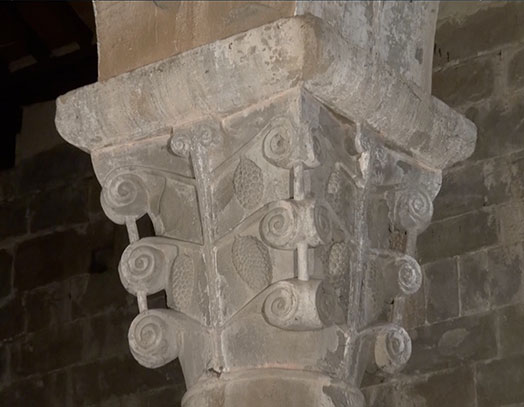THE CAPITAL of the EUCHARIST
right nave, third column
Here one finds a decorative motive similar to the one on the capital with the eagles, this time with only naturalistic and stylized vegetation. Four large bunches of grapes hang in pairs from racemes ending in a double volute on each face and stemming off from a slender column which repeats the motive of the volutes. The lowest shoots do not hold any grapes.
To pagans a cluster of grapes was an attribute of the divinities of fertility and agriculture, and represented the wine of life, and therefore immortality. In Greece it was associated with Dionysus, in Rome with Bacchus. With the advent of Christianity, because of the connection between wine and blood, a sacrificial meaning was preferred, and grapes became the symbol of the Eucharist, especially when associated with grain. A very beautiful Renaissance example is the Madonna of the Eucharist by Sandro Botticelli (from c. 1471-72, in Boston’s Isabella Stewart Gardner Museum). The vine as a plant is another symbol of fertility, often considered to be the tree of life and sacred to gods who die and come back to life. In the Gospel of John Christ it is the True Vine and his disciples are the shoots (John 15, 1-5), but it is also the image of the Church and of the faithful. Mons. Valente Moretti (2004) links this capital with the relief of vegetation sculpted on the base of the pulpit, identifying those, too, as vine-shoots, even though they are much more like stylized oak branches (see the section on the pulpit).
The iconography of the shoots, namely the way in which they were realized and positioned, led Mario Salmi (1971) to compare them to the motive of the Persian haoma. The haoma is a plant sacred to Mazdeism (Zoroastrianism) and it is also the name of one of its divinities. Certainly the motive shows a delicacy and lightness in contrast with the iconographic and figurative richness of the other capitals of the pieve. It’s author oculd have been the same sculptor who made the capital with the eagles behind the pulpit, described in the previous section.

